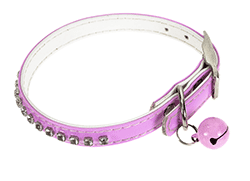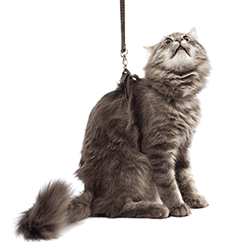Cat collars, harnesses and leads
Collars come in all shapes, designs and sizes. The most important consideration is which is right for your cat

Collar size
A cat's collar should be snug but not tight and a general rule of thumb is that when fitted you should be able to squeeze two fingers under the collar. Bear in mind that if you have a kitten or young cat then their rate of growth means that collar size will need checking often. Collars tend to wear out and need replacing with time, or swapped over if a flea collar is needed - this is a good time to check the collar size, and also check for any skin irritation caused by collar material or type.
Flea collars
If your cat is used to wearing a collar, then a flea collar can help to reduce flea infestations. Whilst some cat owners use flea collars with no problems, the chemicals are generally less effective than spot-on or tablet treatments and may only affect the immediate area. In some cases flea collars can cause irritation and skin rashes. If you use a flea collar make sure you continue to monitor your cat's condition and keep a lookout for fleas through grooming.
Collar styles
A good reflective collar can help prevent your cat from being run over and are a wise choice if you collar your cat. Other collars are available in all shapes, sizes and designs but the most important priority is your cat. A collar with lots of 'bling' may be to your tastes but if it is uncomfortable for your cat, has pieces which might snag, or comes apart easily then it is an unsuitable choice.
Safety collars
Traditional collars are like belts or watch straps and have a pin and buckle to fix them in place. These are very rigid and may pose a threat should the cat become snagged on anything - for instance if falling from a tree the collar could become snagged on a branch and the cat could suffer strangulation. Safety collars are normally made of a more stretchy elastic which the cat can struggle free from, or have a clip which comes undone under pressure. Safety collars offer piece of mind, but they are also more likely to be easily and need regular replacing.

Some cats will enjoy going out on leads. Most will hate the idea
Harnesses and leads
Some cats can be taught to wear a harness and be taken for walks on a lead. This is most easily done with kittens, who are more open to new ideas, although it is possible to get older cats to wear a harness and be taken for walks (this often takes quite a bit of training)
A lead should never be attached directly to a collar, only to a harness. If attached to a collar it will put strain on the cats neck causing strangulation and if the cat should struggle, it is more likely to get caught up and damage itself. A harness spreads the pressure or pull of a lead around the chest rather than the throat.
Getting your cat to wear a collar
Kittens will take to collars easily but if you have an older cat who is not used to wearing a collar it may hate the idea and will take quite a bit of careful training. The first thing to do is simply get the cat used to the collar as an item and this can be done by placing it in the cats bed or favourite areas or handling the collar during times of affection (for example when the cat is being petted, on your lap, or groomed). The next stage is to quickly slip the collar on just before feeding, or before a reward such as a treat or favourite toy. This will distract the cat and for a brief moment the cat will be more interested in the distraction (e.g. food) than the collar. As soon as the cat starts to protest, take the collar off. Eventually the cat should accept the collar for longer periods and then become used to wearing the collar as the normal situation.


